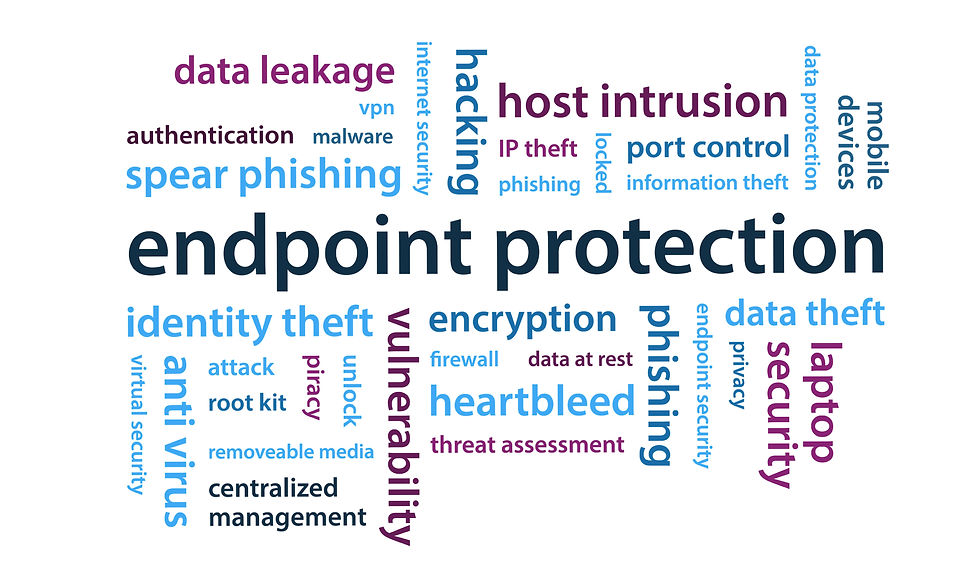Why EDR is Essential for SMBs
- PAGO Networks

- Oct 21
- 5 min read
For small businesses where a single significant breach can threaten business continuity, investments in EDR provide meaningful risk reduction.

Small and medium-sized businesses face the same sophisticated cyber threats as enterprise organizations, but typically operate with constrained security budgets and limited IT personnel. This is how vulnerability gap is created and attackers actively exploit.
Verizon's 2025 Data Breach Investigations Report analyzed over 22,000 security incidents and 12,195 confirmed data breaches. The report reveals that ransomware was present in 88% of breaches at SMB-sized organizations and appeared in 44% of all confirmed breaches, a notable increase from 32% in the previous year. The median ransom payment declined to $115,000 in 2024, with 95% of ransom payments under $3 million.
The attackers target SMBs not out of preference but opportunity. These organizations frequently lack the layered defenses that make enterprise networks harder to penetrate, yet they maintain valuable data including customer information, financial records, and intellectual property.
Verizon's research found that credential abuse at 22% and exploitation of vulnerabilities at 20% continue to be the leading initial attack vectors. Sophos' sixth annual State of Ransomware report, based on a vendor-agnostic survey of 3,400 IT and cybersecurity leaders across 17 countries, identified exploited vulnerabilities as the most common root cause of ransomware incidents, used to penetrate organizations in 32% of attacks.
So then, where the security falls short?
Signature-based antivirus tools operate on a known-threat model. They identify malware by matching files against a database of malicious signatures. This approach fails against polymorphic malware, fileless attacks, and zero-day exploits that evade traditional detection methods.
CISA's Red Team Assessment of a critical infrastructure organization found that the organization relied too heavily on host-based endpoint detection and response solutions and did not implement sufficient network layer protections. EDR detected only a few of the red team's payloads in the organization's Windows and Linux environments. This demonstrates that even with EDR deployed, organizations must configure and monitor these systems properly to gain their full defensive value.
In a recent CISA incident response engagement at a federal agency, EDR alerts were not continuously reviewed, and some public-facing systems lacked endpoint protection entirely. Activity remained undetected for 3 weeks as the agency missed opportunities to detect malicious behavior. The gap becomes more critical when considering that attackers can establish persistence and move laterally through networks rapidly without proper continuous monitoring.
How EDR Changes Detection Capabilities
EDR platforms monitor endpoint activities continuously, recording process executions, network connections, file modifications, and registry changes. This telemetry feeds into behavioral analysis engines that identify anomalous patterns indicative of attacks.
When configured and monitored properly, EDR systems flag behavioral anomalies such as unusual network connections, unexpected process spawning, or abnormal file access patterns. This behavioral approach detects threats that signature-based tools miss.
IBM's 2025 Cost of a Data Breach Report found that organizations were able to identify and contain breaches within a mean time of 241 days, the lowest in 9 years. Organizations using AI-driven security tools extensively, including EDR, saved nearly $1.9 million on average compared to organizations that didn't use these solutions. EDR also provides retrospective analysis capabilities, allowing security teams to query historical endpoint data to identify initial infection vectors, trace lateral movement, and determine the full scope of compromise.
However, detection alone is insufficient without rapid response mechanisms. EDR platforms enable security teams to isolate compromised endpoints from the network within seconds, preventing ransomware spread or data exfiltration. They can remotely terminate malicious processes, delete files, and remediate registry modifications.
Sophos' 2025 State of Ransomware report found that data encryption rates dropped from 70% in 2024 to 50% in 2025, suggesting organizations are more capable of stopping attacks before encrypted payloads are deployed. Over half of victims, 53%, were recovered within a week, a significant jump from the 35% reported in 2024.
For SMBs without dedicated security operations centers, many EDR vendors now offer managed detection and response services. These combine EDR technology with round-the-clock human analysis. The automation capabilities reduce the expertise burden. Rather than requiring deep malware analysis skills, EDR platforms present security teams with contextualized alerts that include recommended response actions. According to Sophos data, ransomware cases accounted for 70% of incident response cases for small business customers in 2024 and over 90% for midsized organizations.
Cost Considerations and ROI
IBM's 2025 Cost of a Data Breach Report found that while global average breach costs dropped to $4.44 million, U.S. organizations faced costs of $10.22 million per breach, driven by regulatory fines and detection costs. The average cost to recover from a ransomware attack, excluding any ransom payment, dropped 44% to $1.53 million in 2025, down from $2.73 million in 2024.
For SMBs, where a single significant breach can threaten business continuity, investments in EDR provide meaningful risk reduction. With the median ransom payment at $115,000, this represents a significant amount for many SMBs. Organizations must weigh upfront EDR costs against the potential expenses of ransomware payments, regulatory fines, customer notification requirements, operational downtime, and reputational damage.
While 64% of organizations chose not to pay ransoms in 2024, up from 50% 2 years ago, this trend reflects improved incident response readiness, greater adoption of immutable backups, and broader legal guidance discouraging payments. EDR capabilities directly enable these improved recovery outcomes by detecting attacks earlier and containing them before data encryption occurs.
Implementation Considerations
SMBs should evaluate EDR solutions based on several criteria beyond detection capabilities. Ease of deployment matters significantly for organizations with limited IT resources. Cloud-native EDR platforms eliminate on-premises infrastructure requirements and simplify updates.
Organizations require continuous training, support, and resources to implement secure software configurations and detect malicious activity. Staff need to continuously enhance their technical competency and gain institutional knowledge of their systems. This underscores the importance of selecting EDR solutions with strong vendor support and clear documentation. Also, integration with existing security tools reduces alert fatigue and improves workflow efficiency. The ability to integrate with firewalls, email security gateways, and identity providers creates a more cohesive security posture.
EDR has transitioned from an enterprise-only technology to an essential security control for organizations of all sizes. The combination of behavioral detection, continuous monitoring, and rapid response capabilities directly addresses the attack techniques that signature-based tools miss.
Recent researches showed that organizations facing ransomware typically have multiple operational challenges, with respondents citing 2.7 factors on average that contributed to them being hit. EDR helps address several of these factors through improved visibility, faster detection, and automated response capabilities.
For SMBs, the question is not whether to implement EDR but rather how quickly they can deploy it effectively. Organizations without these capabilities face significantly longer exposure times and higher costs when attacks succeed.



